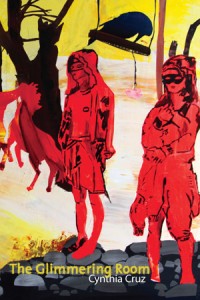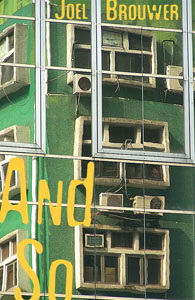WOLF & PILOT by Farrah Field
 Wolf and Pilot
Wolf and Pilot
by Farrah Field
Four Way Books, Oct. 2012
72 pages / $15.95 Buy from Four Way Books or Amazon
The art museum in my hometown of Knoxville has a collection of Narcissa Thorne dioramas, miniature rooms of various fashion and purpose, similar to doll houses. There is a Victorian parlor, a Spanish foyer, a frontier kitchen, all meticulously detailed and like the collection room itself, mostly devoid of people. Each illuminated box presents a stage where any number of actions can take place. The rooms rely on the many arrangements of our imagination—who sat in the armchair, who leaned on the mantelpiece—all the possible scenarios laid out and invisible like precious crime scenes. Yet despite the dramatic combinations an empty stage can offer it’s still bound by purpose: the kitchen is where you cook, the bedroom is where you sleep, and the armchair is where you left it. In the opening poem of Wolf and Pilot—not coincidently inspired by one of Thorne’s rooms—Farrah Field writes:
could walk in on a daily basis, mount a war-period wall clock,
pollute the cold kitchen with pork dumplings, heat the toilet seat.
The poems in Field’s second collection both accept and challenge this mystery. They investigate the nature of absence, the human need to satiate a vacuum, and the gnarled process of memory and apprehension. Centered around four missing sisters, their witch-mother, their beloved teacher and the detective enlisted to find them, Wolf and Pilot is a novella-in-verse which defies its own narrative boundaries.
Echoing Pirandello’s Six Characters, the speakers in Field’s poems are inextricable from the theater of their lives. As per the demands of the story they follow a certain direction, confined to prescribed roles (“What are you supposed to do besides what you have to?”), but this doesn’t stop them from confronting—sometimes bravely, sometimes with caution—their psychological limitations (“We’ll never say this: we want to hang/a sheet from a tree and project movies”). There are moments when the characters are brimming with awareness, their ambitions and failures on display. “You think I’d know what to do,” the detective says, “because I agreed to take care of them.”
July 19th, 2013 / 11:00 am
25 Points: The Glimmering Room
 The Glimmering Room
The Glimmering Room
by Cynthia Cruz
Four Way Books, 2012
98 pages / $15.95 buy from Four Way Books or Amazon
1. “If you bring forth what is within you, what is
within you will save you. If you do not bring
forth what is within you, what is within you
will destroy you.”
—The Gospel of Thomas
2. When I picked up The Glimmering Room I was on a recent, incurably permanent Nine Inch Nails kick. I was listening to The Downward Spiral the minute the book came in, and kept it on for the entirety of the reading.
3. First poem “Kingdom of Dirt” places the material in the world of it’s prelude. The pages are almost hymnal in their design, with white space like musical score margins and titles in austere fonts, like stone engravings. The design works when you get partway through and see it set in deceptively clean and sterile rooms in a psychiatric hospital. It’s surprisingly quiet and deadly against the album playing in the foreground.
4. Like The Downward Spiral, there’s a concept in The Glimmering Room’s organization. I broke up the tracklist on YouTube so I’d force myself to stop and consider the poems, and to consider the album in individual pieces.
5. The thing is, this approach isn’t the primary consumer instruction of either work. There’s a narrative that runs through both, and The Glimmering Room is a concept book on contemporary hysteria much like The Downward Spiral is a concept album describing the descent of a person’s depression into their eventual suicide. Reznor described the album in interviews during the promotion of With Teeth as “friends that sound good next to each other.“
6. In the complete accident of getting the copy as I had this album on, I couldn’t bring myself turn the music. For one, the similarities of self-hatred in the book and the mental boil listening to those textures will make the room too thick to move.
7. And two, the contrast between noise volume of the two works is eerie. Cruz’s first few poems produced a psychological and somatic anxiety that I didn’t want to be left alone with the work, or else I might find myself on a dangerous line. Like I know I can’t drink and sit with The Downward Spiral’s last track in a melancholic mood without it disturbing me into holding a mirror up to myself in a sterile room.
8. The leotards, stuffed animals and tangible suitcases of baggage in The Glimmering Room’s anti-sterility play with the quietness of isolation, which is so intense against the heavy textures of The Downward Spiral that it mimics the lack of movement and external aggression of gendered isolation. While we can journal until oblivion, for a young adult woman, it’s not acceptable to get entropically and endogenously angry, while a young male enjoys the permission and romance of self-destruction anger.
Against the beautiful cover, their outward concerns with looks, the poems contain (apologies introducing the inevitable mad-lady malady cliché) Plathian stillness and resoluteness brightening fuss of blood-smeared text on a white wall.
9. “The traveling minstrel show
Called girlhood—
I burned it
Down to the ground:”
(“Eleven”)
The Downward Spiral was famously recorded at the site of the Tate-La Bianca murders, where “Death to Pigs” was smeared by Mason’s followers, in Tate’s blood, as a “witchy message.” Reznor’s told the story of Sharon Tate’s sister confronting him on a chance encounter during the rental, asking if he was exploiting the mythology of the site he chose. Afterwords, sick with himself, Reznor went back and cried that night, and the house was razed after the completion of the record. After touring, he returned to New Orleans and installed blackout glass in the windows of a funeral parlor in the French Quarter and stayed behind the gates.
10. Like Reznor’s penchant for American history in his material and mental rooms, Cruz doesn’t shirk the critical magnifying glass that details traditional hysteria-as-subject– it refrains from slipping into the bedlam tropes of post-Sexton confessionalism:
“Daddy, I am spit
Pasting junk and shit into glittering
Black pink pearls and beads of apathy.
Track down the pony
Trapped on the carnival-like barge
Lit in key lime green like a California
Ferris wheel to the Rhine,
Back to my Germany
Where this awful song began.
Give me back my Ritalin.
Give me my shock
Of medicine. Make sure my spine
Is still living. Mommy,
Slip the black eel
Back in the sealed aquarium.”
(“Strange Gospels”)
With the blunt diction and tonal speech, the work comes to us traceless of affect as an unmarked envelope, and her language is unrecycled, passing like a cult cinema scene on silent. READ MORE >
April 23rd, 2013 / 3:40 pm
25 Points: And So
 And So
And So
by Joel Brouwer
Four Way Books, 2009
88 pages / $15.95 buy from Four Way Books
1. And So was published in 2009, and so I’m reviewing it now, in 2012.
2. There’s always a time lapse in reading; and so we are all the silhouettes of each other’s ideas of fireflies.
3. Except: we aren’t all silhouettes of each other’s ideas of fireflies. Sometimes we cease to be apart and begin to be together in a way that is (and is not) like a dump cake. It is as Brouwer writes in “In a Motel Halfway to Omaha”: “At dawn she said she had to go to work and he / said not until I do it to you again slut / and she said ok whatever bad man and so” we go on with our dump cake selves.
4. People exist; people have sex. There are people in And So and so they have sex. A lot.
5. If And So were an album, it would be less Marvin Gaye’s Let’s Get It On and more Fiona Apple’s The Idler Wheel is Wiser Than the Driver of the Screw and Whipping Cords Will Serve You More Than Ropes Will Ever Do. And So is not a long title, and so it’s easier to say—which is more important than many things (like shallots).
6. And So is intimately concerned with its use of language, and so am I.
7. The cover art of And So is, to my mind, a series of frames, a series of ways of looking at things (read: people, relationships, the Mona Lisa). I am bothered by our inability to escape from frames, and so the cover art disturbs me.
8. As I break these thoughts to twenty-five pieces—as I frame them—I am wary of: the need for this review; the time that has elapsed between the publishing of this book and the writing of this review; the need for this form for this review; my place in this review; the book’s place in this review; if this review is actually even a review, or if it is a personal essay, co-opting this strange and lovely book of Brouwer’s for its (my) own purpose. I am wary, and so I do what I always do when I am wary: I tell you.
9. But if this were a personal essay, wouldn’t I tell you about my mother, her schizophrenia? I’m not telling you, and so it can’t be a personal essay.
10. But now I’ve told you, and so it must be. Perhaps it always is/was. READ MORE >
October 30th, 2012 / 8:05 pm
